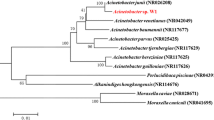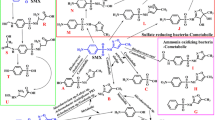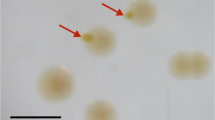Abstract
Sulfamethazine (SM2) is an antimicrobial drug that is frequently detected in manure compost, is difficult to degrade at high temperatures and is potentially threatening to the environment. In this study, a thermophilic bacterium was isolated from the activated sludge of an antibiotics pharmaceutical factory; this bacterium has the ability to degrade SM2 at 70 °C, which is higher than the traditional manure composting temperature. The strain S-07 is closely related to Geobacillus thermoleovorans based on its 16S rRNA gene sequence. The optimal conditions for the degradation of SM2 are 70 °C, pH 6.0, 50 rpm rotation speed and 50 mL of culture volume. More than 95% of the SM2 contained in media was removed via co-metabolism within 24 h, which was a much higher percentage than that of the type strain of G. thermoleovorans. The supernatant from the S-07 culture grown in SM2-containing media showed slightly attenuated antibacterial activity. In addition, strain S-07 was able to degrade other sulfonamides, including sulfadiazine, sulfamethoxazole and sulfamerazine. These results imply that strain S-07 might be a new auxiliary bacterial resource for the biodegradation of sulfonamide residue in manure composting.







Similar content being viewed by others
References
Batt AL, Bruce IB, Aga DS (2006a) Evaluating the vulnerability of surface waters to antibiotic contamination from varying wastewater treatment plant discharges. Environ Pollut 142:295–302
Batt AL, Snow DD, Aga DS (2006b) Occurrence of sulfonamide antimicrobials in private water wells in Washington County, Idaho, USA. Chemosphere 64:1963–1971
Boxall AB, Johnson P, Smith EJ, Sinclair CJ, Stutt E, Levy LS (2006) Uptake of veterinary medicines from soils into plants. J Agric Food Chem 54:2288–2297
Criddle CS (1993) The kinetics of cometabolism. Biotechnol Bioeng 41:1048–1056
DeFlaun MF, Fredrickson JK, Dong H, Pfiffner SM, Onstott TC, Balkwill DL, Streger SH, Stackebrandt E, Knoessen S, van Heerden E (2007) Isolation and characterization of a Geobacillus thermoleovorans strain from an ultra-deep South African gold mine. Syst Appl Microbiol 30:152–164
Dmitrienko SG, Kochuk EV, Apyari VV, Tolmacheva VV, Zolotov YA (2014) Recent advances in sample preparation techniques and methods of sulfonamides detection: a review. Anal Chim Acta 850:6–25
Dolliver H, Kumar K, Gupta S (2007) Sulfamethazine uptake by plants from manure-amended soil. J Environ Qual 36:1224–1230
Dolliver H, Gupta S, Noll S (2008) Antibiotic degradation during manure composting. J Environ Qual 37:1245–1253
Gao PP, Mao DQ, Luo Y, Wang LM, Xu BJ, Xu L (2012) Occurrence of sulfonamide and tetracycline-resistant bacteria and resistance genes in aquaculture environment. Water Res 46:2355–2364
García-Galán M, Silvia Díaz-Cruz M, Barceló D (2008) Identification and determination of metabolites and degradation products of sulfonamide antibiotics. TrAC Trends Anal Chem 27:1008–1022
Grote M, Vockel A, Schwarze D, Mehlich A, Freitag M (2004) Fate of antibiotics in food chain and environment originating from pigfattening (Part 1). Fresenius Environ Bull 13:1216–1224
Herzog B, Lemmer H, Horn H, Müller E (2013) Characterization of pure cultures isolated from sulfamethoxazole-acclimated activated sludge with respect to taxonomic identification and sulfamethoxazole biodegradation potential. BMC Microbiol 13:276
Heuer H, Schmitt H, Smalla K (2011) Antibiotic resistance gene spread due to manure application on agricultural fields. Curr Opin Microbiol 14:236–243
Hirsch R, Ternes T, Haberer K, Kratz KL (1999) Occurrence of antibiotics in the aquatic environment. Sci Total Environ 225:109–118
Hsu JT, Chen CY, Young CW, Chao WL, Li MH, Liu YH, Lin CM, Ying C (2014) Prevalence of sulfonamide-resistant bacteria, resistance genes and integron-associated horizontal gene transfer in natural water bodies and soils adjacent to a swine feedlot in northern Taiwan. J Hazard Mater 277:34–43
Ingerslev F, Halling-Sørensen B (2000) Biodegradability properties of sulfonamides in activated sludge. Environ Toxicol Chem 19:2467–2473
Jiang BC, Li A, Cui D, Cai R, Ma F, Wang YN (2014) Biodegradation and metabolic pathway of sulfamethoxazole by Pseudomonas psychrophila HA-4, a newly isolated cold-adapted sulfamethoxazole-degrading bacterium. Appl Microbiol Biotechnol 98:4671–4681
Kato T, Miyanaga A, Kanaya S, Morikawa M (2010) Gene cloning and characterization of an aldehyde dehydrogenase from long-chain alkane-degrading Geobacillus thermoleovorans B23. Extremophiles 14:33–39
Kim SD, Cho J, Kim IS, Vanderford BJ, Snyder SA (2007) Occurrence and removal of pharmaceuticals and endocrine disruptors in South Korean surface, drinking, and waste waters. Water Res 41:1013–1021
Larcher S, Yargeau V (2011) Biodegradation of sulfamethoxazole by individual and mixed bacteria. Appl Microbiol Biotechnol 91:211–218
Li SS, Li DN, Yan W (2015) Cometabolism of methyl tert-butyl ether by a new microbial consortium ERS. Environ Sci Pollut Res 22:10196–10205
Luo W, Zhu XC, Chen WT, Duan ZB, Wang L, Zhou Y (2014) Mechanisms and strategies of microbial cometabolism in the degradation of organic compounds-chlorinated ethylenes as the model. Water Sci Technol 69:1971–1983
Mitchell SM, Ullman JL, Bary A, Cogger CG, Teel AL, Watts RJ (2015) Antibiotic degradation during thermophilic composting. Water Air Soil Pollut 226:1–12
Müller E, Schussler W, Horn H, Lemmer H (2013) Aerobic biodegradation of the sulfonamide antibiotic sulfamethoxazole by activated sludge applied as co-substrate and sole carbon and nitrogen source. Chemosphere 92:969–978
Obojska A, Ternan NG, Lejczak B, Kafarski P, McMullan G (2002) Organophosphonate utilization by the thermophile Geobacillus caldoxylosilyticus T20. Appl Environ Microbiol 68:2081–2084
Peng XX, Qu XD, Luo WS, Jia XS (2014) Co-metabolic degradation of tetrabromobisphenol A by novel strains of Pseudomonas sp. and Streptococcus sp. Bioresource Technol 169:271–276
Philip S, Sengupta S, Keshavarz T, Roy I (2009) Effect of impeller speed and pH on the production of poly (3-hydroxybutyrate) using Bacillus cereus SPV. Biomacromolecules 10:691–699
Ramaswamy J, Prasher SO, Patel RM, Hussain SA, Barrington SF (2010) The effect of composting on the degradation of a veterinary pharmaceutical. Bioresour Technol 101:2294–2299
Reis PJ, Reis AC, Ricken B, Kolvenbach BA, Manaia CM, Corvini PF, Nunes OC (2014) Biodegradation of sulfamethoxazole and other sulfonamides by Achromobacter denitrificans PR1. J Hazard Mater 280:741–749
Selvam A, Zhao ZY, Li YC, Chen YM, Leung K, Wong J (2013) Degradation of tetracycline and sulfadiazine during continuous thermophilic composting of pig manure and sawdust. Environ Technol 34:2433–2441
Sharma T, Rajor A, Toor AP (2014) Degradation of imidacloprid in liquid by Enterobacter sp. strain ATA1 using co-metabolism. Bioremediat J 18:227–235
Topp E, Chapman R, Devers-Lamrani M, Hartmann A, Marti R, Martin-Laurent F, Sabourin L, Scott A, Sumarah M (2013) Accelerated biodegradation of veterinary antibiotics in agricultural soil following long-term exposure, and isolation of a sulfamethazine-degrading sp. J Environ Qual 42:173–178
Van Dijk J, Keukens HJ (2000) The stability of some veterinary drugs and coccidiostats during composting and storage of laying hen and broiler faeces. In: Ginkel, LA, Ruiter, A (eds) Residues of veterinary drugs in food, Proceedings of the Euro Residue IV Conference, Veldhoven, 8–10 May 356–360
Wang L, Tang Y, Wang S, Liu RL, Liu MZ, Zhang Y, Liang FL, Feng L (2006) Isolation and characterization of a novel thermophilic Bacillus strain degrading long-chain n-alkanes. Extremophiles 10:347–356
Watts C, Crathorne B, Fielding M, Killops S (1982) Nonvolatile organic compounds in treated waters. Environ Health Perspect 46:87
Wu XF, Wei YS, Zheng JX, Zhao X, Zhong WK (2011) The behavior of tetracyclines and their degradation products during swine manure composting. Bioresour Technol 102:5924–5931
Zhang WW, Wen YY, Niu ZL, Yin K, Xu DX, Chen LX (2012) Isolation and characterization of sulfonamide-degrading bacteria Escherichia sp. HS21 and Acinetobacter sp. HS51. World J Microbiol Biotechnol 28:447–452
Acknowledgements
This work was financially supported by grants from the Industry Leading Key Projects of Fujian Province (2015H0044), the FY2015 China-Japan Research Cooperative Program (2016YFE0118000), the Key Project of Young Talent of IUE, CAS (IUEZD201402), the National Natural Science Foundation of China (41373092), the Key Project of Young Talents Frontier of IUE, CAS (IUEQN201501). In addition, the authors sincerely thank Prof. Zhao Feng for providing the Escherichia coli. K12 strain.
Author information
Authors and Affiliations
Corresponding author
Electronic supplementary material
Below is the link to the electronic supplementary material.
Rights and permissions
About this article
Cite this article
Pan, Lj., Tang, Xd., Li, Cx. et al. Biodegradation of sulfamethazine by an isolated thermophile–Geobacillus sp. S-07. World J Microbiol Biotechnol 33, 85 (2017). https://doi.org/10.1007/s11274-017-2245-2
Received:
Accepted:
Published:
DOI: https://doi.org/10.1007/s11274-017-2245-2




